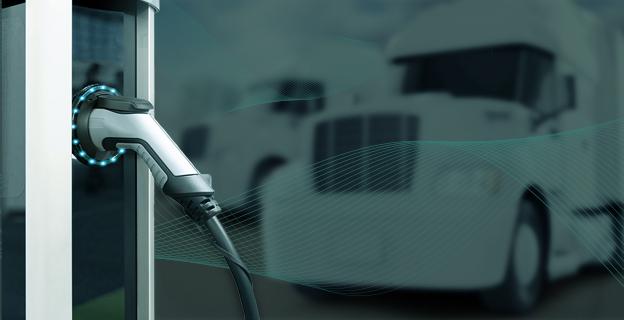4 Min Read • November 8, 2024
Dealers Should Get Ready for Heavy-Duty Electric Trucks Now

Trucking is currently in the “messy middle,” according to the North American Council for Freight Efficiency (NACFE). The NACFE uses this term to describe the transition period as the trucking industry embraces the zero emissions movement. It’s messy because, at this time, fleets have a variety of powertrain options they can deploy in their effort to operate more sustainably.
Today, many fleets are investing in electric heavy-duty vehicles. These include battery electric trucks, fuel-cell electric trucks, hybrids and different renewable fuels. Each option has benefits and challenges, but many signs point to electric trucks as the likeliest long-term solution on the road to zero.
Truck dealers should be ready for this transition.
The Infrastructure Challenge
Perhaps the biggest challenge to electrification is charging infrastructure. Dealers should begin exploring what they need to do to get charging infrastructure in place to charge inventory and customer trucks. They might also consider installing chargers for their customers or other fleets to top off; this convenience could become an additional profit center for dealers.
The biggest impediment to establishing a charging infrastructure — besides the cost — is time. Commercial installation of charging stations can take months — and that’s just for the final step of having the station installed and activated. Before getting to that point, however, dealers may need to modify existing buildings or parking lots to accommodate them. Dealers need to factor that timeline into their planning so they have charging stations ready when they need them.
Dealers will have to go through many steps as they attempt to implement a charging infrastructure and should consider assembling a team that includes the utility provider, the landlord (if they’re renting), authorities with jurisdiction (the entities that enforce building codes and other regulations), and, for brand compliance, the truck manufacturer.
An assessment of the current electrical service capacity and the additional capacity that’ll be needed when charging stations are installed is necessary too. Dealers must also select the type of stations that make sense based on their charging requirements. A site plan should be developed to determine the best place to install the stations, and all necessary permits need to be secured. Only after all that can construction actually begin.
No two utility providers are alike. If dealerships are based in multiple cities or states, they may be dealing with different utilities, each of which may have its own special requirements, processes and procedures.
Two key points to remember when it comes to infrastructure:
- It’ll take longer than you think, so allow adequate planning and installation time.
- Be sure to futureproof the dealership so that you have enough power on the site as more customers add electric trucks.
Prep Your Sales Team
Not all salespeople will be well-versed in the various electric powertrain options available. Dealers should spend time educating their Sales teams, especially in matching powertrain options to vehicle duty cycles, as each powertrain option has a duty cycle in which it works best.
Today, for example, battery electric vehicles (BEVs) make sense in return-to-base short or regional haul applications. Medium-duty box trucks are also good use cases for battery electric trucks. However, in long-haul over-the-road applications, BEVs might not be a good solution as there currently isn’t a truck-oriented national charging infrastructure in place.
Selling the customer a truck that isn’t optimal for its intended use will lead to reliability and durability problems, ultimately resulting in unhappy customers. On the flip side, some fleets may find it a beneficial public relations exercise to be early adopters.
If one of the truck brands your dealership sells offers any EV education on its products, take advantage of those as well.
Prep Your Service Team
While dealership Technicians will be familiar with some components of electric trucks, they’ll also need to learn about new ones. Technicians must be well-acquainted with safety protocols for de-energized EVs prior to maintenance or service events.
Many manufacturers offer service training, and it’s not too soon to take advantage of it. This will ensure that your Technicians will be prepared to work on BEVs safely and efficiently.
Help the Customer
The messy middle and the electric future can be confusing for some fleets. Savvy dealers will position themselves to become a valuable resource to fleets navigating the transition to zero emissions. Begin talking with customers today to learn about their plans so you can help them determine where BEVs make sense and where they’re better served by operating with renewable fuels, hybrids, hydrogen internal combustion engines, fuel cell EVs, or even traditional diesel-powered vehicles.
Offer to be part of the team that tackles the on-site infrastructure issue and share your dealership’s current charging station plans, especially if you’ll allow dealership customers to charge at your locations. And also offer to sit in on meetings with their local utility, architecture and engineering firm, contractors, etc.
Be willing to share any lessons learned from your infrastructure projects to help them avoid pitfalls that’ll slow down the process. The more you can do to help your customers on their electrification journey, the more customer loyalty you’ll earn.
Share This











































